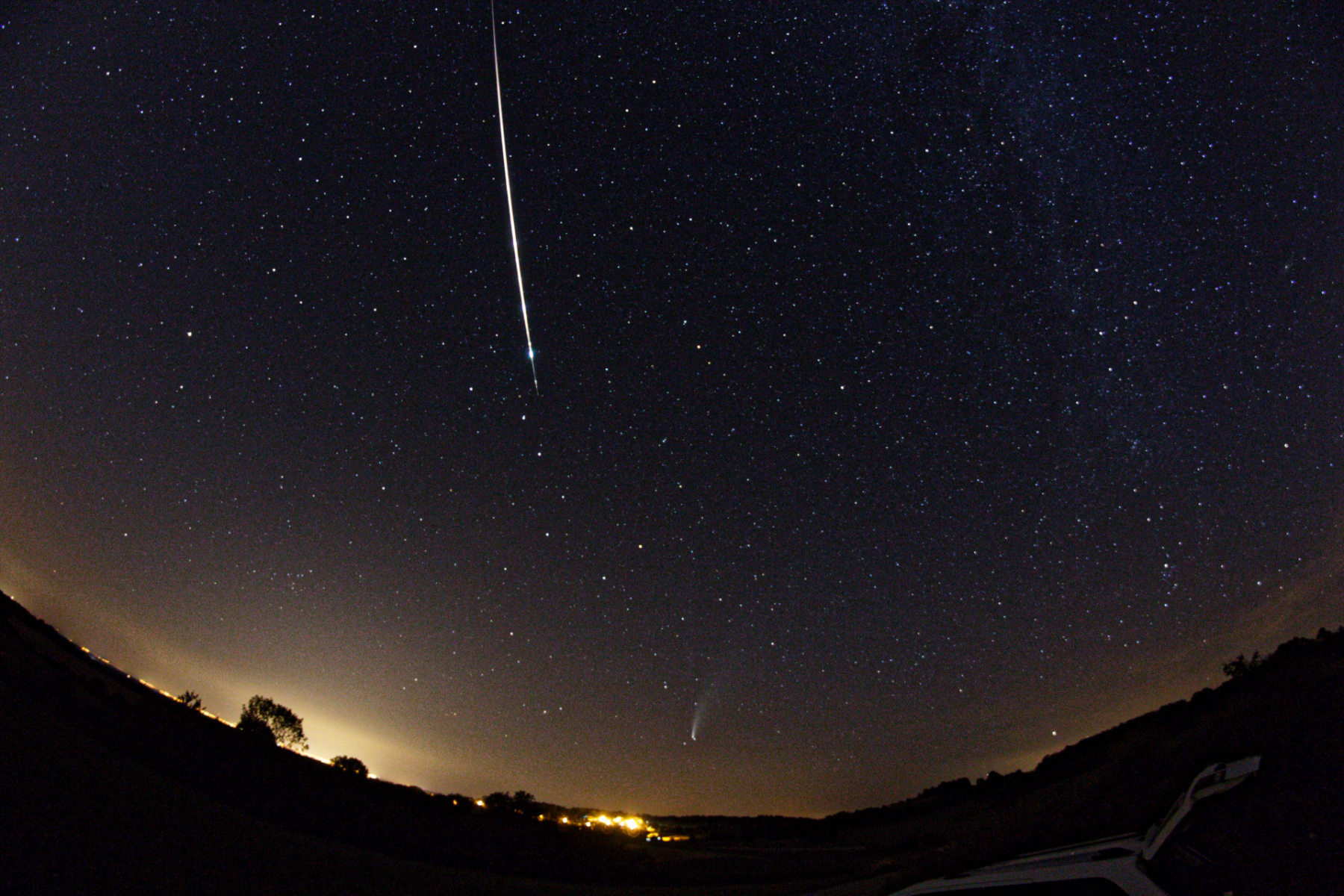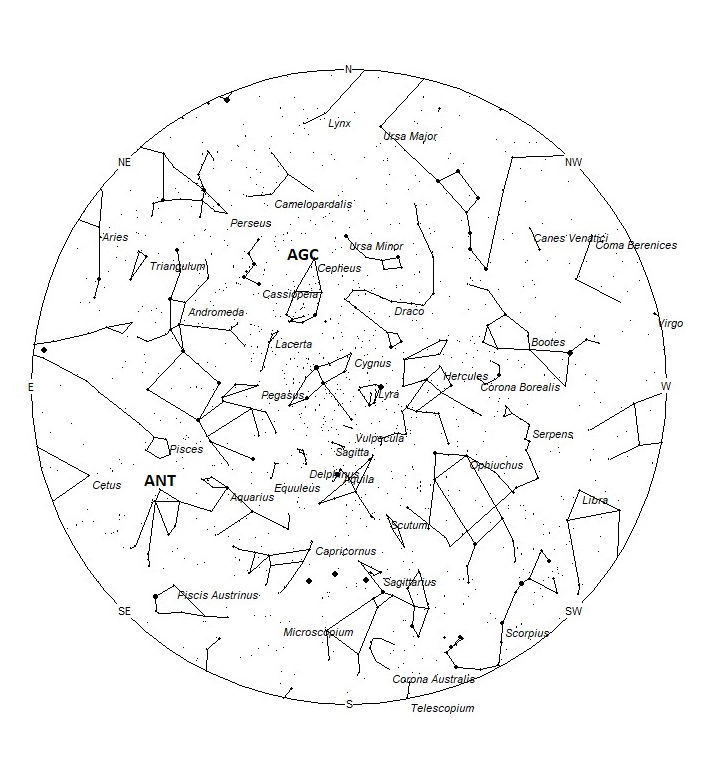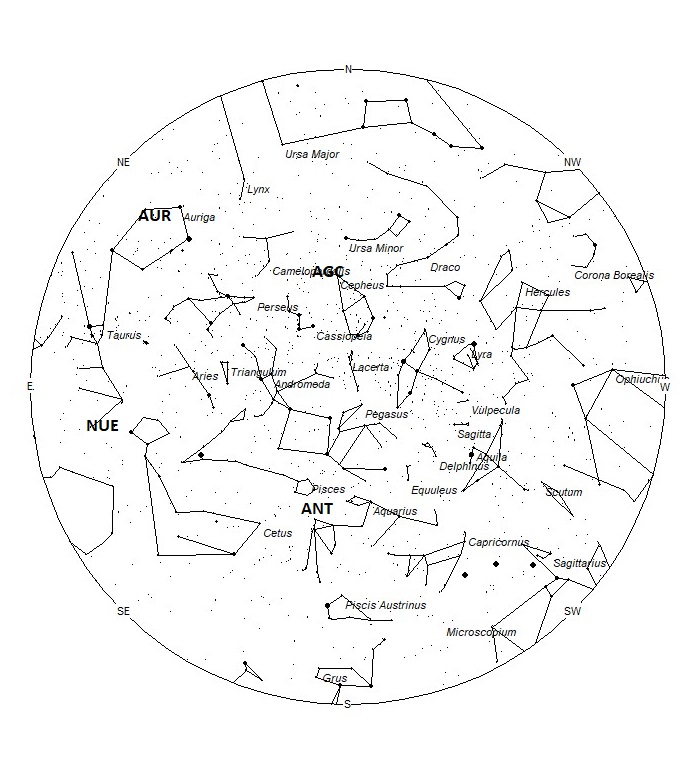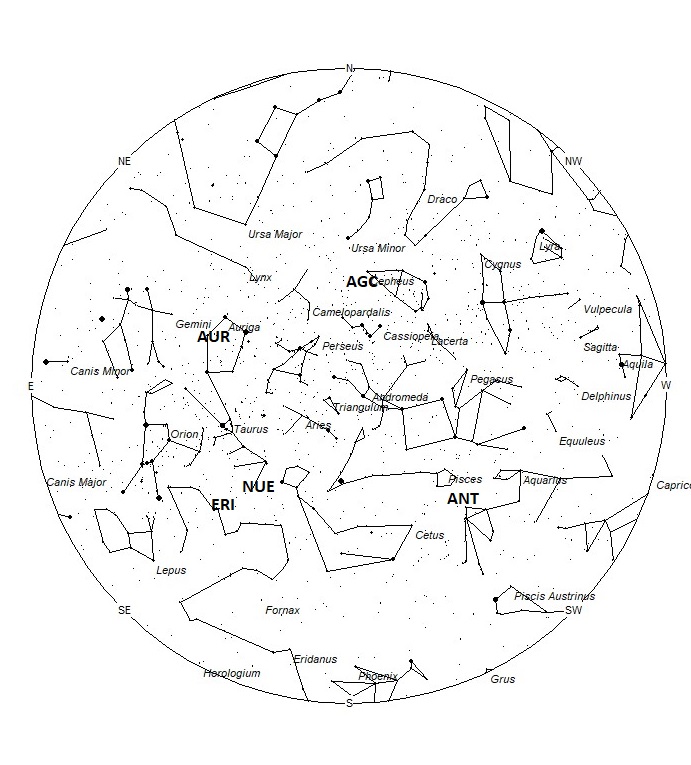
During this period, the moon reaches its full phase on Wednesday September 2nd. At this time, the moon is located opposite the sun and remains above the horizon all night long. This weekend the waxing gibbous moon will set during the early morning hours, allowing a short opportunity to view meteor activity prior to dawn. The estimated total hourly meteor rates for evening observers this week is near 3 as seen from mid-northern latitudes and 2 as seen from tropical southern locations (25S). For morning observers, the estimated total hourly rates should be near 9 as seen from mid-northern latitudes (45N) and 7 as seen from tropical southern locations (25S). The actual rates will also depend on factors such as personal light and motion perception, local weather conditions, alertness, and experience in watching meteor activity. Rates are reduced during this period due to moonlight. Note that the hourly rates listed below are estimates as viewed from dark sky sites away from urban light sources. Observers viewing from urban areas will see less activity as only the brighter meteors will be visible from such locations.
The radiant (the area of the sky where meteors appear to shoot from) positions and rates listed below are exact for Saturday night/Sunday morning August 29/30. These positions do not change greatly day to day so the listed coordinates may be used during this entire period. Most star atlases (available at science stores and planetariums) will provide maps with grid lines of the celestial coordinates so that you may find out exactly where these positions are located in the sky. A planisphere or computer planetarium program is also useful in showing the sky at any time of night on any date of the year. Activity from each radiant is best seen when it is positioned highest in the sky, either due north or south along the meridian, depending on your latitude. It must be remembered that meteor activity is rarely seen at the radiant position. Rather they shoot outwards from the radiant, so it is best to center your field of view so that the radiant lies at the edge and not the center. Viewing there will allow you to easily trace the path of each meteor back to the radiant (if it is a shower member) or in another direction if it is a sporadic. Meteor activity is not seen from radiants that are located far below the horizon. The positions below are listed in a west to east manner in order of right ascension (celestial longitude). The positions listed first are located further west therefore are accessible earlier in the night while those listed further down the list rise later in the night.
These sources of meteoric activity are expected to be active this week.
.
The center of the large Anthelion (ANT) radiant is currently located at 23:16 (349) -05. This position lies in eastern Aquarius, 2 degrees north of the 4th magnitude star known as phi Aquarii. Due to the large size of this radiant, anthelion activity may also appear from western Pisces as well as central Aquarius. This radiant is best placed near 0100 local standard time (LDST), when it lies on the meridian and is located highest in the sky. Rates at this time should be near 2 per hour as no matter your location. With an entry velocity of 30 km/sec., the average anthelion meteor would be of slow velocity.
The August gamma Cepheids (AGC) are a recent discovery by Damir Šegon and the Croatian Meteor Network team based on studying SonotaCo and CMN observations (SonotaCo 2007-2011, CMN 2007-2010). This source is listed as “working” on the IAU website but investigations by Masahiro Koseki have shown that the radiant density ratio is among the highest of all known showers.* This helps prove that this source is real, and I believe it is within reach of visual observers in the northern hemisphere. Meteors from this source are expected from August 19 through September 7, with maximum activity occurring on August 28. The current position lies at 00:05 (001) +77, which lies in northern Cepheus, 2 degrees east of the 3rd magnitude star known as Errai (gamma Cephei A). This radiant is best placed near 0200 LDST, when it lies on the meridian and is located highest in the sky. Rates at this time should be less than 1 per hour as no matter your location. With an entry velocity of 44 km/sec., the average meteor would be of medium-fast velocity.
The nu Eridanids (NUE) were co-discovered by Japanese observers using SonotoCo and Juergen Rendtel and Sirko Molau of the IMO. Activity from this long-period stream stretches from August 24 all the way to November 16. Maximum activity occurs on September 24th. The radiant currently lies at 03:33 (053) +02, which places it in southwestern Taurus, 6 degrees southeast of the 3rd magnitude star known as Menkar (alpha Ceti). This area of the sky is best seen during the last dark hour before dawn when the radiant lies highest in a dark sky. Current rates are expected to be less than 1 per hour during this period no matter your location. With an entry velocity of 67 km/sec., the average meteor from this source would be of swift velocity.
The eta Eridanids (ERI) are active from a radiant located near 04:02 (060) -07. This position lies in northern Eridanus, 2 degrees west of the 4th magnitude star known as Beid (Omicron¹ Eridani). This source is active until September 16th, with maximum activity having occurred on August 10th. Current rates are expected to be less than 1 per hour no matter your location. These meteors are best seen during the last dark hour prior to dawn when the radiant lies highest above the horizon in a dark sky. With an entry velocity of 65 km/sec., the average meteor from this source would be of swift speed.
The Aurigids (AUR) are active from a radiant located at 05:54 (088) +39. This position lies in central Auriga, near the spot occupied by the faint star known as nu Aurigae. This area of the sky is best seen during the last dark hour before dawn when the radiant lies highest in a dark sky. Current rates are expected to be less than 1 per hour no matter your location. Maximum activity is expected on August 31st. With an entry velocity of 67 km/sec., the average meteor from this source would be of swift velocity.
Morning sporadic rates are expected to be near 6 per hour as seen from mid-northern latitudes and 4 as seen from tropical southern latitudes. Evening rates should be near 2 as seen from the northern hemisphere and 1 as seen from tropical southern latitudes. Evening rates are reduced due to interfering moonlight. The list below offers the information from above in tabular form. Rates and positions are exact for Saturday night/Sunday morning except where noted in the shower descriptions.
| SHOWER | DATE OF MAXIMUM ACTIVITY | CELESTIAL POSITION | ENTRY VELOCITY | CULMINATION | HOURLY RATE | CLASS |
| RA (RA in Deg.) DEC | Km/Sec | Local Daylight Saving Time | North-South | |||
| Anthelion (ANT) | – | 23:16 (349) -05 | 30 | 02:00 | 2 – 2 | II |
| August gamma Cepheids (AGC) | Aug 28 | 00:05 (001) +77 | 44 | 03:00 | <1 – <1 | IV |
| nu Eridanids (NUE) | Sep 24 | 03:33 (053) +02 | 67 | 06:00 | <1 – <1 | IV |
| eta Eridanids (ERI) | Aug 10 | 04:02 (060) -07 | 65 | 06:00 | <1 – <1 | IV |
| Aurigids (AUR) | Aug 31 | 05:54 (088) +39 | 67 | 08:00 | <1 – <1 | II |
 American Meteor Society
American Meteor Society



Hello I live in kirkwood MO and I saw things I have never seen in the sky tonight from around 3 am till around 5:30 I’m trying to understand if it was a meteor shower or if not what is going on in the sky near me . I saw what looked like a bright flash that was like a silver flare or firework appear in the sky mid sky about halfway before the horizon line it seemed to fizzle out and burn out fast as turning of a light with a light switch then it disappeared . It seemed to come from and move in a center straight line then pause grow dimmer very fast then arched downward the disappeared. I also saw what looks like a few stars that look orange and like they are blinking in a non uniform pattern and with binoculars I saw that this orange star like mass was actually looking like several various smaller and medium sized lights all appearing as a group but with different brightnesses and sizes . This group of energy or star or whatever also seemed to be vibrating or twinkling and it was located directly above my balcony and it def has not ever been there before . There were a couple of smaller orange masses of lights in the sky not more than a football field away from the one by my balcony . The one by my balcony also seems to be changing in size almost as if it entropying in on itself the getting bigger and then smaller again . Additionally there were several balls of light of what look like stars that are vibrating or flashing slow blinking lights and with binoculars they were made of many different colors of opaque like light like red green blue and white and they also appear to change size . Seeing this has me a little scared and a lot perplexed . Can u tell me what it is I saw ? Thank u
I have seen many times hunting zone
Sitting outside at about 3:30 am in west-central Florida, saw a MASSIVE blue-green meteor fly across the sky! It was so bright and vibrant with sparks trailing behind that my brain thought it was looking at fireworks for a moment.
I saw some teal burst of light that sounds extremely similar to comment from Kirkwood MO. I saw the teal emerald colored light very clearly appear and shoot horizontally and disappear within about 1.5-2 seconds at 11:40pk or so CST here in benbrook Tex Thursday! It was gorgeous!!!!